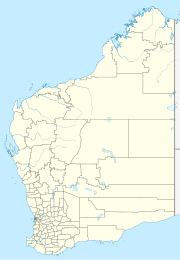Wansbrough, Western Australia
| Wansbrough Western Australia | |||||||||||||||
|---|---|---|---|---|---|---|---|---|---|---|---|---|---|---|---|
 | |||||||||||||||
| Coordinates | 34°10′32″S 117°44′48″E / 34.17545°S 117.74680°E | ||||||||||||||
| Population | 60 (SAL 2021)[1] | ||||||||||||||
| Postcode(s) | 6320 | ||||||||||||||
| Area | 360.7 km2 (139.3 sq mi) | ||||||||||||||
| Location | |||||||||||||||
| LGA(s) | Shire of Broomehill–Tambellup | ||||||||||||||
| State electorate(s) | Roe | ||||||||||||||
| Federal division(s) | O'Connor | ||||||||||||||
| |||||||||||||||
Wansbrough is a rural locality of the Shire of Broomehill–Tambellup in the Great Southern region of Western Australia. The Great Southern Highway and the Great Southern Railway run through the locality from north to south, while the Gordon River forms its north-eastern boundary. The Wansbrough and the Beejenup Nature Reserves are fully located in the locality, while the far northern end of the Balicup Lake Nature Reserve protrudes into the south of Wansbrough. The small eastern part of the gazetted townsite of Pootenup is located in Wansbrough, while the western part is located in Cranbrook, with the border running parallel to the railway line.[2][3]
History
[edit]The west of the Shire of Broomehill–Tambellup is located on the traditional land of the Kaniyang people of the Noongar nation,[4] while the east of the shire is located on the traditional lands of the Koreng people, also of the Noongar nation. Wansbrough is located in the south of the centre of the shire, stretching across both areas.[5][6]
Wansbrough was a siding on the Great Southern Railway until 1992, when the siding closed. The siding originally opened in 1905 as Tingerupp, which was altered to Tingerup and eventually renamed to Wansbrough in 1926.[7][8]
The townsite of Pootenup was also established as a railway siding and gazetted as a town in 1908.[9] The townsite is now forested and has no buildings, with the majority of the western side taken up by the Pootenup Nature Reserve.[2][3]
The heritage listed sites of the Tingerup race club, school and hall are located within Wansbrough, south of Wansbrough Nature Reserve. The racecourse is on the lake formerly called Lake Tingerup, now Racecourse Lake, part of the Cranbrook Pink Lakes.[10]
Nature reserves
[edit]The Wansbrough Nature Reserve was gazetted on 14 July 1978, has a size of 1.26 square kilometres (0.49 sq mi), and is located within the Avon Wheatbelt bioregion.[11]
The Beejenup Nature Reserve was gazetted on 23 October 1970, has a size of 0.5 square kilometres (0.19 sq mi), and is located within the Avon Wheatbelt and Esperance Plains bioregions.[11]
The Balicup Lake Nature Reserve was gazetted on 21 December 1923, has a size of 6.87 square kilometres (2.65 sq mi), and is also located within the Avon Wheatbelt bioregion.[11]
References
[edit]- ^ Australian Bureau of Statistics (28 June 2022). "Wansbrough (suburb and locality)". Australian Census 2021 QuickStats. Retrieved 28 June 2022.
- ^ a b "SLIP Map". maps.slip.wa.gov.au. Landgate. Retrieved 2 November 2024.
- ^ a b "NationalMap". nationalmap.gov.au. Geoscience Australia. Retrieved 2 November 2024.
- ^ "Kaneang (WA)". www.samuseum.sa.gov.au. South Australian Museum. Retrieved 2 November 2024.
- ^ "Koreng (WA)". www.samuseum.sa.gov.au. South Australian Museum. Retrieved 2 November 2024.
- ^ "Map of Indigenous Australia". aiatsis.gov.au. Australian Institute of Aboriginal and Torres Strait Islander Studies. 14 May 2024. Retrieved 2 November 2024.
- ^ "Railway map of Western Australia, 1952". Trove. Retrieved 2 November 2024.
- ^ "Back Along the Line: Section 31 Avon Yard - Albany" (PDF). Retrieved 2 November 2024.
- ^ "History of country town names – P". Western Australian Land Information Authority. Archived from the original on 14 March 2022. Retrieved 2 November 2024.
- ^ "Tingerup search results". inherit.stateheritage.wa.gov.au. Heritage Council of Western Australia. Retrieved 2 November 2024.
- ^ a b c "Terrestrial CAPAD 2022 WA summary". www.dcceew.gov.au/. Department of Climate Change, Energy, the Environment and Water. Retrieved 2 November 2024.
